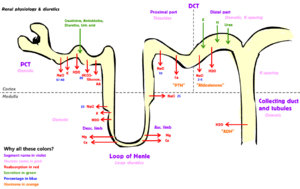High ceiling loop diuretic
High ceiling diuretics are diuretics that may cause a substantial diuresis – up to 20% of the filtered load of NaCl and water. This is huge when compared to normal renal sodium reabsorption which leaves only ~0.4% of filtered sodium in the urine.
Loop diuretics have this ability, and are therefore often synonymous with high ceiling diuretics. Loop diuretics, such as furosemide, inhibit the body's ability to reabsorb sodium at the ascending loop in the nephron which leads to a retention of water in the urine as water normally follows sodium back into the extracellular fluid (ECF). Other examples of high ceiling loop diuretics include ethacrynic acid,torsemide and bumetanide.
Thiazides
Thiazide-type diuretics such as hydrochlorothiazide act on the distal convoluted tubule and inhibit the sodium-chloride symporter leading to a retention of water in the urine, as water normally follows penetrating solutes. Frequent urination is due to the increased loss of water that has not been retained from the body as a result of a concomitant relationship with sodium loss from the convoluted tubule. The short-term anti-hypertensive action is based on the fact that thiazides decrease preload, decreasing blood pressure. On the other hand the long-term effect is due to an unknown vasodilator effect that decreases blood pressure by decreasing resistance.
Carbonic Anhydrase Inhibitors
Carbonic anhydrase inhibitors inhibit the enzyme carbonic anhydrase which is found in the proximal convoluted tubule. This results in several effects including bicarbonate retention in the urine, potassium retention in urine and decreased sodium absorption. Drugs in this class include acetazolamide and methazolamide.
Digitalis
Digitalis increases output of urine by increasing cardiac output and increasing circulation through the kidneys. Digitalis has a diuretic effect on heart failure patients due to cardiac edema.
Potassium-sparing diuretics
These are diuretics which do not promote the secretion of potassium into the urine; thus, potassium is spared and not lost as much as in other diuretics. The term "potassium-sparing" refers to an effect rather than a mechanism or location; nonetheless, the term almost always refers to two specific classes that have their effect at similar locations:
- Aldosterone antagonists: spironolactone, which is a competitive antagonist of aldosterone. Aldosterone normally adds sodium channels in the principal cells of the collecting duct and late distal tubule of the nephron. Spironolactone prevents aldosterone from entering the principal cells, preventing sodium reabsorption. A similar agent is potassium canreonate.
Calcium-sparing diuretics
The term "calcium-sparing diuretic" is sometimes used to identify agents that result in a relatively low rate of excretion of calcium.
The reduced concentration of calcium in the urine can lead to an increased rate of calcium in serum. The sparing effect on calcium can be beneficial in hypocalcemia, or unwanted in hypercalcemia.
The thiazides and potassium-sparing diuretics are considered to be calcium-sparing diuretics.
- The thiazides cause a net decrease in calcium lost in urine.
- The potassium-sparing diuretics cause a net increase in calcium lost in urine, but the increase is much smaller than the increase associated with other diuretic classes.
By contrast, loop diuretics promote a significant increase calcium excretion. This can increase risk of reduced bone density.
Osmotic diuretics
Compounds such as mannitol are filtered in the glomerulus, but cannot be reabsorbed. Their presence leads to an increase in the osmolarity of the filtrate. To maintain osmotic balance, water is retained in the urine.
Glucose, like mannitol, is a sugar that can behave as an osmotic diuretic. Unlike mannitol, glucose is commonly found in the blood. However, in certain conditions such as diabetes mellitus, the concentration of glucose in the blood (hyperglycemia) exceeds the maximum reabsorption capacity of the kidney. When this happens, glucose remains in the filtrate, leading to the osmotic retention of water in the urine. Glucosuria causes a loss of hypotonic water and Na+ leading to a hypertonic state with signs of volume depletion such as: dry mucosa, hypotension, tachycardia, and decreased turgor of the skin. Use of some drugs, especially stimulants may also increase blood glucose and thus increase urination.
Low ceiling diuretics
The term "low ceiling diuretic" is used to indicate that a diuretic has a rapidly flattening dose effect curve (in contrast to "high ceiling", where the relationship is close to linear). It refers to a pharmacological profile, not a chemical structure. However, there are certain classes of diuretic which usually fall into this category, such as the thiazides.

No comments:
Post a Comment